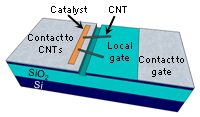Research:Gate-controlled generation of optical pulse trains using individual carbon nanotubes
Excitons in nanotubes display a variety of unique interactions that could be used to achieve unconventional functionalities in nanoscale photonics and optoelectronics. Previously, we found that gate-voltages quench photoluminescence through carrier-mediated exciton relaxation. Here we utilize such a process to generate optical pulse trains that can be controlled electrically.


In our devices, air-suspended carbon nanotubes (CNTs) are contacted on one side of a trench, and a local gate on the opposite side is used for applying electric fields onto the CNTs. The use of the top silicon layer of a silicon-on-insulator substrate allows for efficient and fast gating. Interestingly, we find that gate-induced quenching can be eliminated at high frequencies when square-wave voltages are applied. This implies that voltage transitions can reset the CNTs to become bright again temporarily to produce optical pulses.

Indeed, time-resolved measurements of photoluminescence unambiguously shows the existence of a series of pulses that are synchronized with the gate voltage transitions. The device effectively converts an electrical clock into an optical pulse train with twice the frequency. These results identify an unconventional route for optical pulse generation and electrical-to-optical signal conversion, opening up new prospects for controlling light at the nanoscale.
To learn more about this work, please refer to:
Gate-controlled generation of optical pulse trains using individual carbon nanotubes
Nature Commun.
6, 6335 (2015).
![]()